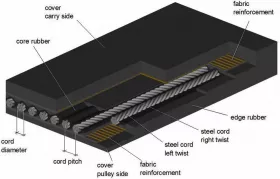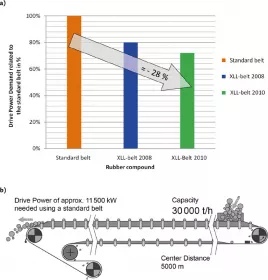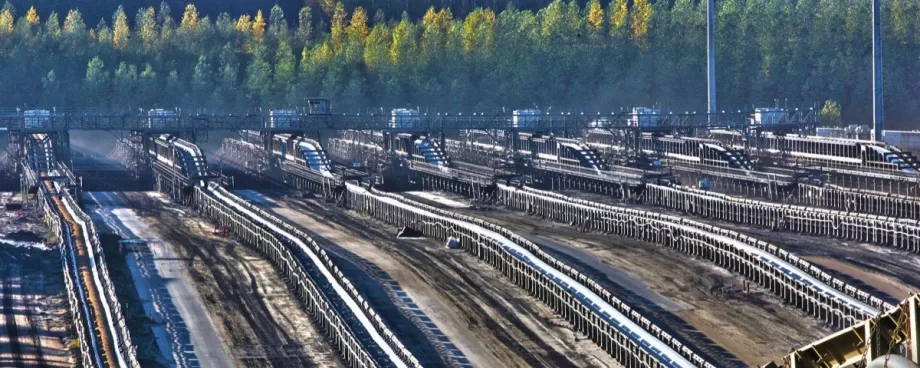Seel cord belts are in widespread use in the mining industry. They are used primarily for long-distance conveyors, heavy mining machinery (rotary disc excavators, overburden conveyor gantries, tractor shovels, bucket-chain excavators, stackers, spreaders, loaders, etc.), short- and middle-distance belt conveyors in surface mining and in general wherever high conveying capacities and small takeups are required. In this connection, two important properties of a steel cord conveyor belt compared to a fabric ply conveyor belt are critical: high nominal breaking strengths with low reference elongations. Today, conveyor belt designers have at their disposal a broad range of design standards and modern materials, meaning that belt manufacturers are able to design conveyor belts in a cost-efficient and application-oriented way – corresponding exactly to the customer’s needs. This article provides an overview of the opportunities relating to how belt manufacturers and end customers can jointly achieve these goals. Furthermore, the new product Stahlcord Barrier from the Contitech Conveyor Belt Group is presented here as an example for this approach.
Various Standards influence the Design of Steel Cord Conveyor Belts
The selection of the cord breaking strength or the cord diameter and the cord pitch of a steel cord conveyor belt has a strong influence not just on its manufacturing costs and the degree of difficulty of the splicing, but also on elements of the belt conveyor system. For example, in the selection of a pulley diameter conforming to DIN 22101 [1], a cord diameter is multiplied by a numerical factor. This value is used in combination with the pulley load factor in the determination of the system’s pulley diameter. Fig. 1 shows a typical steel cord conveyor belt along with its components and important parameters.

Depending on the application, the parameters and components of a conveyor belt are determined by the belt manufacturer in consultation with the customer. In terms of design, it is often not just internationally known standards that are taken into account, but also the internal company standards of the customer. In addition to many national standards (AS, CEMA, GOST, DIN, NF, etc.), the following standards are most frequently used in the design of a steel cord conveyor belt and its splice.
- German Industrial Standard DIN 22131 parts 1 to 4 [2]
- International Standard EN ISO 15236 parts 1 to 4 [3]
- Australian Standard AS1333 [4]
In spite of the fact that DIN 22131 has been withdrawn and replaced by EN ISO 15236 (DIN EN ISO 15236), DIN 22131 is still used worldwide because of the many years of good experience of OEMs and end customers.
In all three standards, the recommendations for selecting the parameters for a steel cord conveyor belt are summarized in the form of a table. This table with preferred belt types contains information about minimum breaking strength of a belt (N/mm), maximum cord diameter, minimum breaking strength of the cord, cord pitch, minimum thickness of the cover plates, and the number of cords as a function of the belt width. Therefore, the design of belt types of St500 to St5400 or St6300 that are used most often is predetermined. The recommended belt designs always include strength reserves that are achieved by higher cord breaking strength and number of cords. Depending on the application, the strength reserves should be critically analyzed because they can result in increased costs of a steel cord conveyor belt and the system components (e.g. pulley).
The German Industrial Standard DIN 22131 part 1 specifies that the breaking strength of a steel cord vulcanized into the conveyor belt must be at least as great as the product of minimum breaking strength of the conveyor belt and the cord pitch according to the table with recommended belt designs, with an allowance of approximately 10%. The Australian Standard AS1333 determines for each belt strength class and belt width the number of cords, cord pitch, and minimum cord breaking strength. Therefore, the strength reserves are pre-programmed in both standards.
While German or Australian standards allow low “freedom” in the design of a steel cord conveyor belt, the International Standard EN ISO 15236 (and DIN EN ISO 15236, resp.) is more flexible in this regard. In addition to the recommended belt designs conforming to EN ISO 15236-A1 and -A2, the following applies in the selection of the number of cords:
“Based on the minimum breaking strength of the cord Fbs in kN, the minimum breaking strength of the belt (kN) in N/mm, and the width of the belt B in mm, the minimum number of cords (nmin) is calculated according to the following equation:“

|
“The actual number of cords, n, must be greater than or equal to nmin. The number of cords in the tables should be regarded as a recommendation only. It results from the equation Eq. (1) and from the requirement that the edge width cannot be greater than 40 mm and cannot be less than 15 mm”, i.e.:

|
“A higher number of cords as well as a lower number can be selected if the conditions are met with regard to the minimum breaking strength as defined in EN ISO 15236-1 and EN ISO 15236-4.”

|
Table 1 shows the comparison between designs according to three standards for an example belt 2200 St2500 12:6 X: From this table, it is evident that the design conforming to International Standard EN ISO 15236 compared to Australian Standard AS1333 makes for a belt that is not just approximately 11% lighter and approximately 11% less expensive, but also makes it possible for the drive pulley diameter of a belt conveyor system to be reduced by 36 %. (Compare design conforming to AS1333 and “Based on EN ISO 15236 A2”). A slight increase of the cord pitch by 0.5 mm has a positive effect on the belt splice.
| Standard for Design of 2200 St2500 12-6 X | Cord diameter ø, mm | Cord diameter ø, mm | Cord Pitch, mm | Cord Number | Effective Belt Breaking Strength, N/mm | Weight Difference, % | Manufactur. Costs Difference, % | Acc. to DIN 22101 selected Drive Pulley Diameter > 145 x Cord-ø, mm |
| AS 1333 | 7.6 | 52 | 19.4 | 111 | 2624 | 100.7 | 108.7 | 1250 |
| DIN 22131 | 6.8 | 41.2 | 15 | 144 | 2697 | 100.0 | 100.0 | 1000 |
| EN ISO 15236 A1 | 6.8 | 41.2 | 15 | 142 | 2659 | 99.6 | 99.7 | 1000 |
| EN ISO 15236 A2 | 5.1 | 26.6 | 10 | 214 | 2587 | 90.3 | 98.6 | 800 |
| Based on EN ISO 15236 A2 | 5.1 | 26.6 | 10.5 | 207 | 2503 | 89.6 | 97.9 | 800 |
From this a general recommendation can be formulated for economical belt design: “In the case of belt design, a large number of thin cords should be preferred.” However, this rule only applies if the dynamic splice efficiency of the belt splices of at least 45%, which is required according to DIN 22101, is ensured. Often with long-distance conveyors having a center distance exceeding 1000 meters, customers require a higher dynamic splice efficiency of the belt splice than 45 %. This is especially applicable for long-distance conveyors having a center distance extending over several kilometers (often 10 km or more), where service lifes for a belt of 10 to 15 years are expected.
Steel Cord Conveyor Belts with and without Extra Low Loss Bottom Cover
In the design of a steel cord conveyor belt for horizontal long-distance conveyors (center distance exceeding 1000 m), the selection of the rubber compound for the bottom cover is of great significance. With the bottom cover made of a proper rubber compound, the indentation rolling resistance (IRR) can be significantly reduced. With long-distance conveyors, the IRR is responsible for 50% to 70% of the total resistance [5] (Fig. 2). This effect is strengthened with increasing center distance of a long-distance conveyor.
![Fig. 3: Loss deformation of the bottom cover of a conveyor belt when running over an idler. (Picture: © Wennekamp [6])](/sites/default/files/public/styles/basic_small_mobile/public/2024-01/wp_1107.jpg.webp)
The R&D department of Contitech is continually engaged in the further development of extra low loss conveyor belts with the rubber compound “XLL” (XLL = eXtraLowLoss). Thus, for example, Fig. 4 shows a 28% reduction in the required drive power from approx. 11 500 kW down to 8280 kW for a 5000 meter long horizontal conveyor with a conveying capacity of 30 000 metric t/hr at conveying velocity of 7.5 m/s when a modern XLL conveyor belt is used compared to the conveyor belt with the bottom cover made of a standard commercially available compound. This means for the example in Fig. 4 b, that:
- The emissions of CO2 can be reduced by 32 523 metric tons/year (assuming the CO2 emission coefficient for lignite of 1.153 kg/kWh and 24/7-operation per year consisting of 365 days).
- With the 3220 kW energy saved, up to 8955 private households can be supplied per year (assuming an average power consumption of one German household of 3150 kWh per year).
- EUR 1.41 million/year can be saved by a lignite power plant (assuming the average electricity generation costs of EUR 0.05/kWh in Germany).

With the use of XLL rubber compound, not just the required drive power but the installed motor power can also be reduced. Due to the reduced motion resistance, a conveyor belt with a smaller nominal breaking strength than the conventional conveyor belt can be selected. As a result, the conveyor belt and the drive and tail pulleys of the belt conveyor system become “lighter” and more economical.
The end result is a belt conveyor system with a “lighter” and more economical conveyor belt, “smaller” motors or with a reduced number of motors, smaller drive and tail pulley diameters, a lighter tensioning device, and lighter steel construction, etc., which makes it possible to sharply reduce the costs for the entire system. Table 2 shows a feasibility study for a parallel OLC-2 long-distance conveyor at KPC mine (Kaltim Prima Coal), where the belt conveyor system is compared to a steel cord conveyor belt with and without a bottom XLL rubber compound. In [7], the OLC-1 long-distance conveyor was described well.
| Parameters | OLC-2 long-distance conveyor with a ContiTech XLL conveyor belt (current version) | OLC-2 long-distance conveyor with a ContiTech XLL conveyor belt (current version) | Difference Δ |
| Required Perf and installed Pinst drive power | Perf = 3219 kW; Pinst = 4400 kW (2×2200 kW at the head end) | Perf = 4970 kW; Pinst = 6600 kW (2×2200 kW at the head end and1×2200 kW at the tail end) | ΔPerf = 1751 kW; ΔPinst = 2200 kW (one additional drive) |
| Conveyor belt type, cord diameter dS, nominal belt breaking strength kN, and belt mass per meter m’G | 1100 St2250 5.5:5.5 X/XLL, dS = 5.1 mm, kN = 2250 N/mm, m’G = 29.2 kg/m | 1100 St2800 5.5:5.5, dS = 6.3 mm, kN = 2800 N/mm, m’G = 34.3 kg/m | ΔkN = 550 N/mm, Δm’G = 5.1 kg/m |
| Required min. drive pulley diameter DTr,min | DTr,min > 145∙dS → DTr,min = 1000 mm (according to DIN 22101 with the pulley load factor > 100%) | DTr,min > 145∙dS → DTr,min = 1250 mm (according to DIN 22101 with the pulley load factor > 100%) | ΔDTr,min= 250 mm |
| Max. belt tension during startup | TANmax = 570 kN | TANmax = 684 kN | ΔTANmax= 114 kN |




















